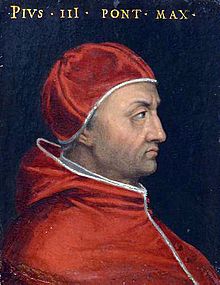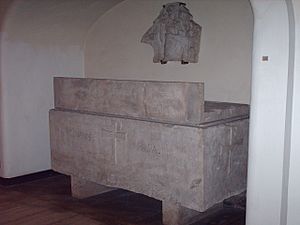Pope Pius III facts for kids
Quick facts for kids Pope Pius III |
|
|---|---|
| Bishop of Rome, Duke of Amalfi | |
 |
|
| Church | Catholic Church |
| Papacy began | 22 September 1503 |
| Papacy ended | 18 October 1503 |
| Predecessor | Alexander VI |
| Successor | Julius II |
| Orders | |
| Ordination | 30 September 1503 |
| Consecration | 1 October 1503 by Giuliano della Rovere |
| Created Cardinal | 5 March 1460 |
| Personal details | |
| Birth name | Francesco Todeschini Piccolomini |
| Born | 9 May 1439 Sarteano, Republic of Siena |
| Died | 18 October 1503 (aged 64) Rome, Papal States |
| Buried | St. Peter's Basilica, later moved to Sant'Andrea della Valle |
| Previous post |
|
| Other Popes named Pius | |
Pope Pius III (born Francesco Todeschini) was the leader of the Catholic Church and the ruler of the Papal States. He was born on May 9, 1439, and died on October 18, 1503. He became pope on September 22, 1503. His time as pope lasted only twenty-six days, making it one of the shortest in history.
Francesco was the nephew of Pope Pius II. His uncle allowed him to use the family name "Piccolomini." He also made the 21-year-old Francesco the Archbishop of Siena. Francesco served as a special representative for the pope in many places. In 1503, Cardinal Piccolomini was chosen as pope. He was a compromise choice between two powerful families, the Borgia and della Rovere. He planned to make big changes, but he died less than a month later.
Contents
Life of Pope Pius III
Early Years and Education
Francesco Todeschini Piccolomini was born in Sarteano on May 9, 1439. He was part of the House of Piccolomini. His mother, Laudomia Piccolomini, was the sister of Aeneas Silvius Piccolomini, who later became Pope Pius II.
As a boy, Francesco joined his uncle's household. His uncle let him use the Piccolomini family name and symbols. Francesco studied Canon Law at the University of Perugia. He earned a special degree called a doctorate after finishing his studies.
Becoming a Cardinal
In 1457, Francesco Todeschini-Piccolomini was given an important church job. It was the office of Provost of the Collegiate Church in Xanten. He held this job for many years.
His uncle, Aeneas Silvius Piccolomini, became Pope Pius II in 1458. Pope Pius II made his nephew a cardinal on March 5, 1460. He named him Cardinal-Deacon of Sant'Eustachio. Francesco was also made the administrator of the Archdiocese of Siena. This meant he managed the church in Siena. He did not become a bishop until just before he was crowned pope.
Cardinal Francesco also owned the monastery of San Saba in Rome. He spent a lot of money to fix up and decorate the old buildings there.
Important Missions and Roles
In 1460, Pope Pius II sent Cardinal Francesco to the March of Ancona. This was an important area in Italy. He did a good job and proved to be very effective.
He was also made the archdeacon of Brabant in Cambrai in 1462. He held this position until 1503. In 1464, he was named the Pope's representative for Rome and the Papal States. This happened when Pope Pius II left Rome to start a crusade.
Papal Elections and Influence
Francesco Todeschini Piccolomini took part in several papal elections, called conclaves.
- 1464 Conclave: He was part of the election that chose Pope Paul II. Even though he was the nephew of the previous pope, he had less influence than expected.
- 1471 Conclave: He was away on a mission in Germany when Pope Sixtus IV was elected.
- 1484 Conclave: He participated in the election of Pope Innocent VIII. As the senior cardinal deacon, he announced the new pope and crowned him. He was known for not being involved in any secret deals during this election.
- 1492 Conclave: He was part of the election that chose Pope Alexander VI. He was one of the cardinals who did not want Rodrigo Borgia to become pope. However, he still announced and crowned the new pope.
He also served as a "protector" for England and Germany in Rome. This meant he looked after their interests at the papal court. He was also sent on a mission to King Charles VIII of France in 1494.
The Piccolomini Library
In 1502, Cardinal Piccolomini ordered a special library to be built. It was located in the Duomo di Siena. This library was meant to hold the collection of books from his uncle, Pope Pius II.
He hired the famous artist Pinturicchio to paint the ceiling and walls. The paintings show scenes from the life of his uncle, Aeneas Silvius Piccolomini. Even though the library was beautifully decorated, the books never actually arrived there. Today, the Piccolomini Library is a famous example of Renaissance art in Siena.
Becoming Pope Pius III
The Papal Election of 1503
Pope Alexander VI died on August 18, 1503. After his death, there was a lot of unrest in Rome. The cardinals needed to choose a new pope. They wanted to make sure the election was fair.
The election, called a conclave, began on September 16. Cardinal Piccolomini was elected pope on September 22, 1503. He chose the name "Pius III" to honor his uncle, Pius II. He was chosen as a compromise candidate. This meant he was a good choice for both the powerful Borgia and della Rovere families. He was also an older, experienced cardinal.
Plans for the Church
On September 25, the new pope held a meeting with cardinals and ambassadors. This was unusual to do before his coronation. He wanted to bring peace between the kings of France and Spain.
Pope Pius III also announced his main goals as pope:
- To make immediate changes to the church.
- To create a council of cardinals to help him.
- To manage the church's money more carefully.
- To bring peace to the Papal States.
He told the Venetian ambassador that he did not want to be a "warlike" pope. He wanted to be a "peace-loving" pope. He allowed French soldiers to pass by Rome, but not through the city center.
Pius III also supported Cesare Borgia, a powerful military leader. He confirmed Borgia's role as the church's military commander. He even allowed Borgia to come to Rome for safety.
Short Reign and Death
On September 26, the new pope had surgery on his leg. He was suffering from an ulcer. The next day, he said he would not be able to do the traditional ceremony of taking possession of his cathedral because of his leg.
Francesco Piccolomini had never been ordained as a priest. He was only a deacon. So, on September 30, 1503, he finally became a priest. The next day, October 1, he was consecrated as a bishop. Both ceremonies were done by Cardinal Giuliano della Rovere.
A few days later, on October 3, reports said the pope had a high fever and severe leg pain. People already started talking about who would be the next pope.
His coronation took place on October 8, 1503. Some parts of the ceremony had to be skipped because of his leg. He even said Mass while sitting down.
Pope Pius III died on October 18, 1503. He had been pope for only 26 days. He died from an infection in his leg ulcer. Some people thought he might have been poisoned, but this was never proven.
He was buried in St. Peter's Basilica next to his uncle, Pius II. Later, their remains were moved to the church of Sant'Andrea della Valle in Rome.
See also
 In Spanish: Pío III para niños
In Spanish: Pío III para niños
Images for kids



